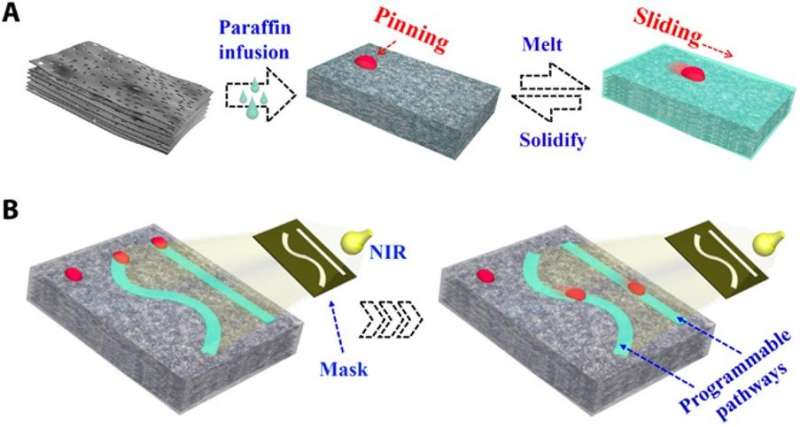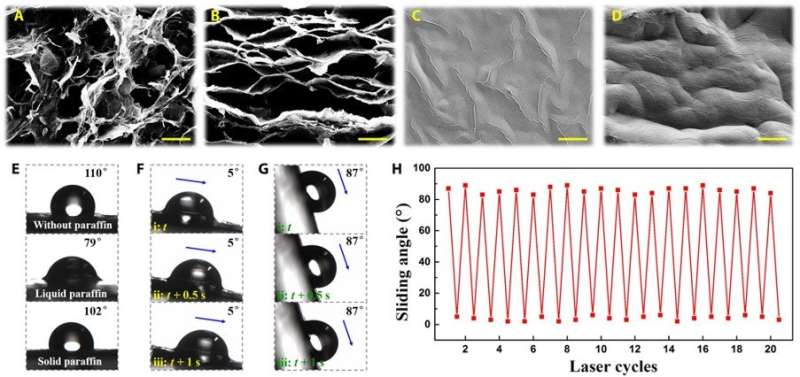September 20, 2018 feature
Paraffin-infused porous graphene film (PIPGF) with programmable wettability

In materials science, the surface wettability of a biomaterial can be measured using the surface water contact angle as an important characterization of its hydrophilicity or hydrophobicity. The technique has attracted remarkable attention in recent years for materials development in the areas of energy, healthcare and environmental science. Bioinspired surfaces have been engineered with a variety of functionalities and special properties of wettability to mimic nature.
Among these, slippery liquid-infused porous surfaces (SLIPSs) outperformed their natural counterparts to provide state-of-the-art surfaces with stable and defect-free repellence for a variety of simple and complex liquids. To broaden the application of SLIPSs with tunable wettability, adaptive surfaces were made of liquid film supported by a nanoporous elastic substrate. Although contact-based regulation underwent many such improvements to enable the existing slippery surfaces, their space-time control via non-contact remain unrealized. In addition, slippery surfaces with programmable wettability that can spatiotemporally manipulate droplets for a breakthrough impact in microfluidics technology remain to be developed.
Now writing in Science Advances, Wang et al. present a novel, paraffin-infused porous graphene film (PIPGF) consisting of a porous graphene sponge material infused with paraffin. The process allowed paraffin to reversibly transition between solid and liquid phases with the photothermal effect of graphene under near-infrared (NIR) light. When the paraffin surface was heated to melting, water droplets could slide down along the graphene film, and when the paraffin was cooled, droplets pinned to the film surface. The surface wettability and state of matter of PIPGF could be remotely controlled with high stability and fast reversibility using NIR light. The authors integrated NIR masks so that paraffin could melt at corresponding patterns on the PIPGF to form programmable pathways for the slipping droplets. The PIPGF facilitated programmable wettability pathways to simplify liquid handling in microplates, droplet microarrays and in distinct microfluidic microreactors with potential for applications in blood grouping diagnosis. The features conferred versatility to the photocontrollable PIPGF platforms for applications involving droplet manipulation.

In the study, reduced graphene oxide (GO) hitherto referred to as graphene, was added to a mold prepared with two flat glass slides to create the 3-D graphene sponge film. Ionic bonding with Ca2+ (CaCl2), followed by reduction with hydroiodic acid (HI) and subsequent freeze drying enabled the porous structure formation. The graphene sponge film was investigated with scanning electron microscopy (SEM) to observe a honeycomb-like architecture with high specific surface areas. Surface hydrophobicity and the porous network structure of the graphene sponge film enabled the infusion of melted paraffin liquid into the pores of the sponge to construct a slippery surface. Capillary forces and matching chemistry between the liquid paraffin and solid graphene surfaces enabled uniform coverage of the graphene scaffold, showing apparent wrinkles and uniform coating of paraffin on the graphene sponge film.

The transition of paraffin from solid to liquid in PIPGF could be remotely controlled with easy operation, high stability and fast reversibility using NIR light. The surface wettability of PIPGF was measured with NIR switched on/off to determine the contact and sliding angles of water droplets on its surface. At first, the water contact angle on the graphene sponge film demonstrated surface hydrophobicity (~1100); thereafter, a decreased contact angle was observed on the PIPGF with NIR switched on (~790) and off (~1020), indicating comparative surface hydrophilicity.
The sliding angle of the water droplet was only 50 with the laser switched on, whereas the angle increased (870) when the laser was switched off. Such NIR-controlled tunable wettability of the PIPGF provides a promising method for dynamically manipulating the mobility of droplets on a surface on demand, for tunable and reversibly repellent droplet handling technologies.
The authors integrated additional NIR masks on the PIPGF, to enable programmable wettability pathways for spatiotemporal droplet manipulation. When using NIR masks, the irradiated paraffin melted in the desired pattern to become slippery, while the unirradiated part remained rough. The ability to control the droplet guiding pathway on PIPGF surfaces for programmable spatiotemporal droplet flexibility is of significance for microfluidic technologies.

To demonstrate practical applications of NIR-controlled programmable wettability pathways, the authors used PIPGF for liquid handling in microplate technology to create a greatly simplified yet accurate and reusable pipetting process. Different samples could be pipetted into wells simultaneously to conserve time.
In addition, the PIPGF with more complex Y-shaped or Y-Y composite channels could be programmed to form distinctive microreactors for controlled droplet-based chemical merging reactions. The applications highlight the potential of PIPGF in microfluidic systems and in laboratory-on-a-chip settings. To demonstrate its potential in practice, the authors conducted a human blood grouping (ABO and Rh) diagnosis using the platform. An individual's blood type can be detected by monitoring the hemagglutination reaction between antigens and antibodies, which traditionally requires observational skills and facilities. In the study, the authors simply monitored blood grouping after mixing with antibodies, to detect if the composite blood groups slid down the PIPGF or not. Blood drops with no hemagglutination reaction slid, whereas blood drops where agglutination occurred remained pinned to the PIPGF surface.

The volume ratios of blood droplets to antibody droplets should be precisely optimized to influence the reaction time of hemagglutination. The simple detection and significant results on PIPGF microreactors may find important roles in cost-effective, clinical blood grouping applications. Photocontrollable PIPGF can form intelligent droplet microfluidic systems, with expansive features for programmable, multidisciplinary wettability applications in chemistry, materials engineering, energy and healthcare.
More information: Jie Wang et al. Programmable wettability on photocontrolled graphene film, Science Advances (2018). DOI: 10.1126/sciadv.aat7392
Mingjie Liu et al. Nature-inspired superwettability systems, Nature Reviews Materials (2017). DOI: 10.1038/natrevmats.2017.36
Tak-Sing Wong et al. Bioinspired self-repairing slippery surfaces with pressure-stable omniphobicity, Nature (2011). DOI: 10.1038/nature10447
Journal information: Science Advances , Nature
© 2018 Phys.org




















